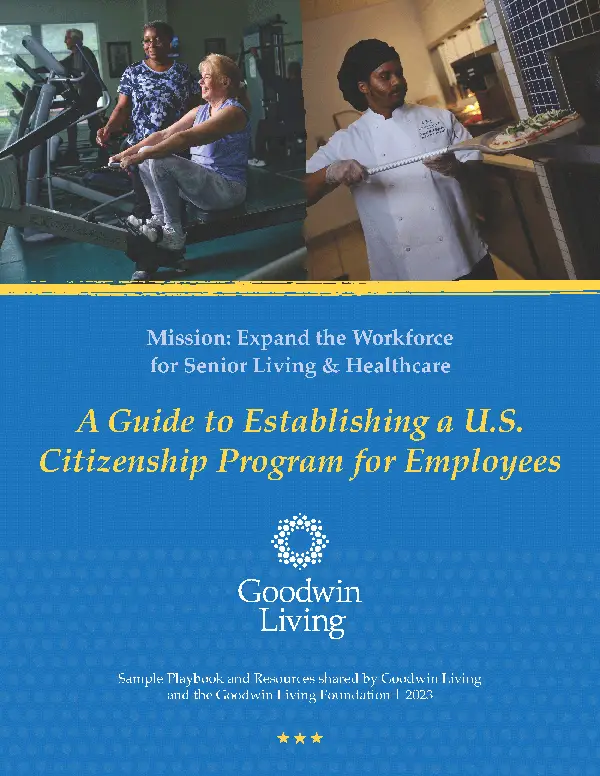
Live Comfortably - July 24, 2023
By Leslie LaPlace
“Breathe. Don’t hold your breath.”
If you’ve been in any fitness classes over the last few years, you may have heard these reminders. Why do fitness instructors feel the need to remind people to do something that we already do automatically? It turns out that there is more to this instruction than meets the eye.
When exercising, it’s easier than you might think to forget to breathe. You might inadvertently hold your breath while pushing through a tough moment, focusing on your form or even thinking about errands you need to run later. We sometimes hold our breath as a way to stabilize our core, the muscles in and around the torso that support the spine, pelvis and trunk. If you hold your breath during more demanding exercises, before you know it you might start feeling lightheaded and unsteady.
Breathing properly during exercise involves more than not holding your breath. Though it can be tricky to be mindful of your breathing patterns while exercising, doing so is crucial to maintaining a safe and healthy workout routine. Engaging in rapid shallow breathing will prevent the lungs from filling completely, making the transportation of oxygen to your muscles much more difficult.
The best breathing practice during exercise involves drawing deep breaths from the belly, allowing for more oxygen and blood flow to our muscles and brain. This provides the body with energy and helps it avoid a drop in blood pressure while performing high resistance activities, which can help mitigate accidents and injury. The energy it provides is necessary when exercising because your body is working harder than normal and needs as much oxygen as possible.
Practicing safe breathing techniques also increases the speed of your recovery from a workout and keeps your overall daily energy levels higher. Breathing deeply can also help relieve stress from your mind and tension in your body. Combined with the right movements, proper breathing can bring the most wellness out of your workouts.
The same muscles responsible for breathing are also the key muscles involved in standing and sitting up straight. These muscles make up your core region. Thus, taking full, deep breaths can improve one’s posture while sitting and standing, as well as during exercise.
Let’s take a look at some good breathing techniques to practice during your next workout.
When performing strength training exercises, it is usually best to exhale on the exertion and inhale on the relaxation. Below are some common strength training exercises and their proper breathing techniques.
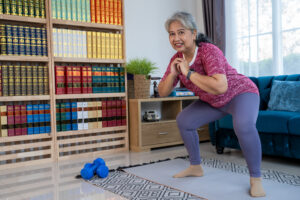
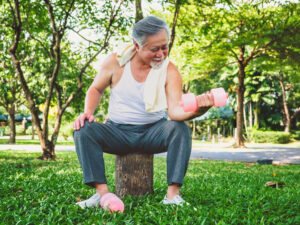
 Pulling exercises: These involve the lateral pulldown and seated row machine. Inhale on the exertion (as you pull) to expand the chest and pull the shoulder blades together. Exhale on the return (as you release).
Pulling exercises: These involve the lateral pulldown and seated row machine. Inhale on the exertion (as you pull) to expand the chest and pull the shoulder blades together. Exhale on the return (as you release).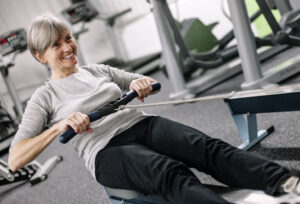
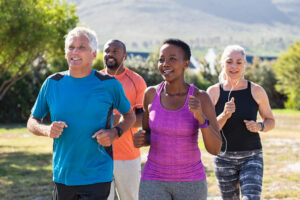 When performing cardio exercises such as running, jumping jacks or swimming, it’s especially important to practice the belly breathing discussed earlier in this article so that you’re using your full lung capacity. Many people also find rhythmic breathing to be a powerful tool during cardio.
When performing cardio exercises such as running, jumping jacks or swimming, it’s especially important to practice the belly breathing discussed earlier in this article so that you’re using your full lung capacity. Many people also find rhythmic breathing to be a powerful tool during cardio.
To practice rhythmic breathing, inhale for three beats (or steps, if you’re running) and exhale for two beats. If you’re going at a quicker pace and need even more oxygen, you could try inhaling for two beats and exhaling for one. As you practice this, inhale through your nose and exhale through your mouth.
Proper breathing patterns during core work are a cross between the breaths used for strength training and those used for cardio. Some exercises will lend better to one pattern than the other.

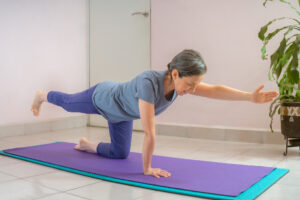

Don’t forget to continue to breathe when cooling down or stretching. Remember to practice deep, slow breathing which helps calm the body and aid in recovery. Breathe through your nose as you focus on each inhale and exhale.
By using the proper breathing methods and patterns during your workout, you’ll be supporting your body and maximizing the benefits of each exercise. Always remember – keep breathing!
_________________________________
Leslie LaPlace, Fitness Manager at Goodwin House Alexandria, is self described recovering Software Development Project Manager. Leslie parlayed a lifelong love of and belief in the restorative power of exercise into a satisfying career working with adults ages 55 and older. She believes that staying active can help reduce aches and pains—It’s also a great anti-aging remedy. She has more than six years’ experience working with seniors at Arlington County, The Jefferson, Goodwin House Bailey’s Crossroads and Goodwin House Alexandria. Leslie is a certified personal trainer and aquatic instructor who loves creating a positive and fun training experience. She believes that it’s never too late to improve your strength and balance!
